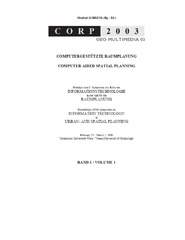Приказ основних података о документу
Possibilities of applying the E-government management concept in Serbian cities
| dc.contributor | Schrenk, Manfred | |
| dc.creator | Lalović, Ksenija | |
| dc.creator | Đukanović, Zoran | |
| dc.date.accessioned | 2020-04-06T18:41:35Z | |
| dc.date.available | 2020-04-06T18:41:35Z | |
| dc.date.issued | 2003 | |
| dc.identifier.isbn | 3-901673-09-1 | |
| dc.identifier.uri | https://raf.arh.bg.ac.rs/handle/123456789/565 | |
| dc.description.abstract | Recent urban transformations worldwide consequentially lead to the numerous environmental problems that have to be solved by complex structure of social interest groups which have to be included in that process. This demands initiated requisitioning and modification of concepts and methodologies of planning and managing urban development. At this moment there are different models used in world wide practice, but main bases of new methods and techniques are the same. Leaving the idea of possibility of constituting the universal urban planning model lead to very productive results in developing the disciplinary methodologies. Process of transformation of traditional comprehensive urban planning model to integrated procedural pluralistic model (based on sustainable development principles) is something that can be underlined as a main characteristic of disciplinary development. The questions of decision making mechanisms and plans implementation are put in axes of conceptual and methodological considerations. Urban planning loses the classic form of making the multi level comprehensive urban plans with exact spatial and time horizon. It means, in general that planning and managing of urban development is aiming to be realistic, decentralized, strategic and problem oriented, arbitrary, not instructive, but understood as a efficient and effective process. Operational support to the this kind of approach are Decision Support IT tools, such as GIS - Geographical Information Systems or ES -Expert Systems. Usability of IT tools is based on their capability to perform fast and complicated processing of spatial data and on their flexibility towards specific real problems which are to be solved. In order to use maximum of capabilities of these tools in practice problem solving it is necessary to adjust their structure and usage to the: - actual conditions of socioeconomic of the context in which urban development planning and management is performed, - practical demands that managing of urban development has to fore fill, - all participants in urban management process, - institutional mechanisms and procedures. | en |
| dc.language.iso | en | sr |
| dc.publisher | Wien : Selbstverlag des Institutes für EDV-gestützte Methoden in Architektur und Raumplanung der Technischen Universität Wien | sr |
| dc.rights | openAccess | sr |
| dc.source | Treffpunkt der Planerinnen : 8. internationales Symposion zur Rolle der Informationstechnologie in der und für die Planung sowie zu den Wechselwirkungen zwischen realem und virtuellem Raum ; Tagungsband 2003 = Meeting-place for planners : 8th international symposion on information and communication technologies in urban and spatial planning and impacts of ICT on physical space ; proceedings 2003 ; February 25 - March 1, 2003 TU Wien = CORP 2003 = GEO MULTIMEDIA 03 | sr |
| dc.subject | Urban transformations | sr |
| dc.subject | Urban planning model | sr |
| dc.subject | Decision Support IT tools | sr |
| dc.subject | GIS - Geographical Information Systems | sr |
| dc.subject | ES -Expert Systems | sr |
| dc.subject | E-government management concept | sr |
| dc.title | Possibilities of applying the E-government management concept in Serbian cities | en |
| dc.type | conferenceObject | sr |
| dc.rights.license | ARR | sr |
| dcterms.abstract | Лаловић, Ксенија; Ђукановић, Зоран; | |
| dc.citation.spage | 339 | |
| dc.citation.epage | 343 | |
| dc.identifier.fulltext | https://raf.arh.bg.ac.rs/bitstream/id/1464/CORP2003_proceedingsLalovicKDjukanovicZ.pdf | |
| dc.identifier.rcub | https://hdl.handle.net/21.15107/rcub_raf_565 | |
| dc.type.version | publishedVersion | sr |

